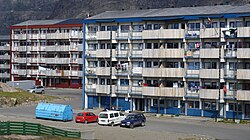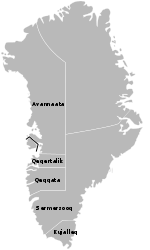Sisimiut
Sisimiut | |
|---|---|
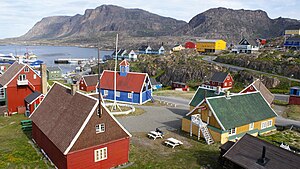 Sisimiut centrum, Kangerluarsunnguaq Bay, and the massif of Palasip Qaqqaa | |
| Federacy | Kingdom of Denmark |
| Country | |
| Municipality | Qeqqata |
| First settled | 2500 BCE |
| Founded | 1721 |
| Government | |
| • Mayor | Hermann Berthelsen (Siumut) |
| Population (2010) | |
| • Total | 5,460 |
| Time zone | UTC-03 |
| Postal code | |
| Website | sisimiut.gl |
Sisimiut (Danish: Holsteinsborg) is a town in central-western Greenland, located on the coast of Davis Strait. It is the administrative center of the Qeqqata Municipality and the second-largest town in Greenland. The site of the present-day town has been inhabited for the last 4,500 years. The first inhabitants were the Inuit peoples of the Saqqaq culture, Dorset culture, and then the Thule people, whose descendants form the majority of the current population. Artifacts from the early settlement era can be found throughout the region, favored in the past for its plentiful fauna, particularly the marine mammals providing subsistence for the early hunting societies. The population of modern Greenlanders in Sisimiut is a mix of the Inuit and Danish peoples, who first settled in the area in the 1720s, under the leadership of the Danish missionary, Hans Egede.
Today, Sisimiut is one of the fastest growing towns in Greenland, with a population of over 5,000 people. It is the largest business center north of Nuuk, the capital of Greenland. Architecturally, Sisimiut is a mix of traditional, single-family houses, and communal housing, with apartment blocks raised in the 1960s during a period of town expansion in Greenland. Sisimiut is still expanding, with the area north of the port, on the shore of the small Kangerluarsunnguaq Bay reserved for a modern suburb-style housing slated for construction in the 2010s. Several professional and general schools are based in Sisimiut, providing education to the inhabitants of the town and to those from smaller settlements in the region. The new Taseralik Culture Center is the second Cultural Center to be established in Greenland, after Katuaq in Nuuk. It hosts concerts and travelling theatre troupes.
The town has its own bus line, and is the northernmost year-round ice-free port in the country, a shipping base for western and northwestern Greenland. Supply ships heading from the commercial port towards smaller settlements in the more remote regions of Uummannaq Fjord, Upernavik Archipelago, and as far as Qaanaaq in northern Greenland. The town airport is served by Air Greenland, providing connections to other towns on the western coast of Greenland, and through Kangerlussuaq Airport, to Europe.
History
Prehistory
Saqqaq culture

Sisimiut has been a settlement site for around 4,500 years, with the people of the Saqqaq culture arriving from Arctic Canada during the first wave of immigration, occupying numerous sites on the coast of western Greenland.[4] At that time, the shoreline was up to several dozen meters above the present line, gradually decreasing in time due to post-glacial rebound.[3]
The Saqqaq remained in western Greenland for nearly two millennia.[5] Unlike the following waves of migrants in the millennium following their disappearance, the Saqqaq left behind a substantial number of artifacts, with plentiful archeological finds on the coast of Davis Strait, from Disko Bay (Greenlandic: Qeqertarsuup Tunua) in the north—to the coast of Labrador Sea near Nuuk in the south.[4]
Research at the Asummiut excavation site near the airport[6] has uncovered the changing settlement pattern, exhibiting transition from the single-family dwellings to tiny villages of several families. The types of dwelling varied from tent rings made of the hides of hunted mammals, to stone hearths, with no evidence of communal living in larger structures.[4] In contrast, there is evidence for reindeer hunting as a coordinated effort of either villagers or groups of more loosely related individuals, with gathering places in proximity of the hunting grounds being found.[4]
Despite recent advances in DNA research based on hair samples from the ancient Saqqaq migrants (which gives insight into their origin), the reason for the decline and subsequent disappearance of the culture are not yet known.[7]

Dorset culture
After several hundred years of no permanent habitation, the second wave of migration arrived from Canada, bringing the Dorset people to western Greenland.[5] The first wave of immigrants, known as Dorset I, arrived around 500 BCE, inhabiting the region for the next 700 years.[5] The early Dorset people were followed later by the Dorset II people, although no artifacts have been discovered from the later era around Sisimiut,[5] and few artifacts from the era of Dorset I have been uncovered in archaeological sites, with the finds often limited to harpoon heads and numerous animal bones.[9] The largest number of Dorset culture artifacts can be found further north in the Disko Bay region, while the further to the south, the poorer the finds, disappearing completely on the coast of Labrador Sea in southwestern Greenland.[9]
1000–1700
Thule people
The Inuit of the Thule culture—whose descendants form the majority of the current population—arrived nearly a thousand years ago, with the first arrivals dated to approximately 13th and 14th century. The Thule people were more technologically advanced that their Dorset predecessors, although they still relied on subsistence hunting, with walruses, reindeer, and particularly the fur seals constituting the base of the economy in the early period.[10]
The shoreline was still at a higher altitude than today, with the Sisimiut valley east of the Kangerluarsunnguaq Bay, partially under sea. Many artifacts and graves from the several centuries of permanent settlement remain scattered in the region. Rich in fauna, the coastal region from Sisimiut to Kangaamiut was particularly attractive for migrants, and due to a large number of historical artifacts it is currently listed as a candidate for the UNESCO World Heritage Site, with the application received in 2003.[11]
Europeans
There are no signs of Norse settlement in the region. The Dutch whalers did not remain in the area for long.[12] It wasn't until the early 18th century that a significant population of settlers from Europe arrived.
Colonial era
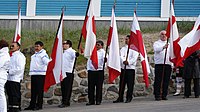

The first Europeans to settle permanently around Sisimiut were the Danes. Hans Egede, the missionary to Greenland, arrived in 1721 and established his church in the vicinity. The first settlement, a whaling station at Nipisat in the area was located approximately 30 km (19 mi) to the north of the present-day town.[14][12] In 1764 the settlement was moved to the present-day site.[15] The colonists formally established several villages in the region, of which only two remain to this day: Itilleq and Sarfannguit.[14]
Several eighteenth century buildings still stand in Sisimiut, among them the oldest church in Greenland—the Bethel church dating from 1775—and Gammelhuset (the old house), dating from 1725.[15] The buildings were moved from the former site of the settlement at Ukiivik (Holsteinsborg) together with the rest of the settlement. The new church on the rocky pedestal was built in 1926, further extended in 1984.[15] The entrance to the yard with the old church and other protected historical buildings is decorated with a unique gate made of whale jawbone.[15]
In 1801, a smallpox epidemic decimated the population of Sisimiut and other coastal settlements, although the population growth quickly resumed due to plentiful marine life on the coast.[14]
20th century
The twentieth century saw industrialization, through the construction of a shipping port, and a fish processing factory of Royal Greenland in 1924, the first such factory in Greenland.[12] Fishing remains the primary occupation of Sisimiut inhabitants, with the town becoming the leading center of shrimping and shrimp processing.[15]
Municipal center
Until 2008 Sisimiut had been the administrative center of Sisimiut Municipality, which was then incorporated into the new Qeqqata Muncipality on 1 January 2009, with Sisimiut retaining its status as the administrative center of the new unit, consisting also of the former Maniitsoq Municipality and the previously unincorporated area of Kangerlussuaq.[17]
Geography
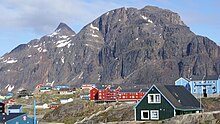
Sisimiut is located 75 km (47 mi) north of the Arctic Circle,[15] on the eastern shores of Davis Strait, perched on a series of rocky outcrops at the western end of a large peninsula bounded from the north by the Kangerluarsuk Tulleq fjord and from the south by the wide Amerloq Fjord.
Kangerluarsunnguaq Bay
Immediately to the north of Sisimiut a small inlet of Davis Strait, the Kangerluarsunnguaq Bay (Danish: Ulkebugten), separates the town from the Palasip Qaqqaa massif in the north, at the southern foot of which the town airport is located.[18] The 544 m (1,785 ft)[18] high twin summit commands a wide view in all directions, with the majority of the coast of the Qeqqata municipality visible in good conditions.

The bay is navigable in its entirety, protected from the open sea by a series of skerries in the west. Both the local port and the local sailing harbor are located on the southern shore of the bay. The 4.1 km (13,000 ft)[19] road to the airport passes through the bridge over the Kangerluarsunnguaq Bay. Halfway between the town and the airport there is a small beach of dark sand. The beach, as well as the skerries off the coast, are very popular in the summer.
Alanngorsuaq

To the east, a wide valley extends into the interior of the peninsula, bounded from the north by the conjoint massif of Palasip Qaqqaa and Majoriaq, dissected by the Qerrortusup Majoriaa valley[18] alongside which leads the Polar Route from Sisimiut to Kangerlussuaq.[20] Depending on variants, the route is between 150 km (93 mi) and 170 km (110 mi) long.
In the middle of the valley towers a standalone Alanngorsuaq mountain (411 m (1,348 ft)), surrounded by several lakes, one of which serves Sisimiut town as a water reservoir. The entire area of the valley is another popular picnic destination, with easy access to the water reservoirs by a gravel road in the middle part of the valley. The reservoirs in the valley provide the town waterworks with 882,000 m3 (1,154,000 cu yd) of water, with the potential for 7,200,000 m3 (9,400,000 cu yd) annually.[21]
Nasaasaaq
To the southeast, the valley is bounded by the Nasaasaaq massif with several distinct summits, the highest of which is 784 m (2,572 ft).[18] One of the variants of the Polar Route follows the coast of Amerloq Fjord at the base of the southern wall of Nasaasaaq.[20]
Climate
Sisimiut lies within the polar climate region, belonging to the E group of the Köppen climate classification. The average temperature is 10 °C (50 °F) or lower throughout the year.[22] The sea winds from Davis Strait moderate the climate, with the area known for its fogs.[15]
| Climate data for Sisimiut, Greenland (1961-1990) | |||||||||||||
|---|---|---|---|---|---|---|---|---|---|---|---|---|---|
| Month | Jan | Feb | Mar | Apr | May | Jun | Jul | Aug | Sep | Oct | Nov | Dec | Year |
| Mean daily maximum °C (°F) | −9.4 (15.1) |
−10.2 (13.6) |
−10.1 (13.8) |
−3.6 (25.5) |
2.9 (37.2) |
6.8 (44.2) |
9.8 (49.6) |
9.3 (48.7) |
5.8 (42.4) |
0.7 (33.3) |
−3.2 (26.2) |
−6.9 (19.6) |
−0.7 (30.8) |
| Mean daily minimum °C (°F) | −16.3 (2.7) |
−17.7 (0.1) |
−18.0 (−0.4) |
−10.9 (12.4) |
−3.2 (26.2) |
0.8 (33.4) |
3.3 (37.9) |
3.3 (37.9) |
0.7 (33.3) |
−4.4 (24.1) |
−8.7 (16.3) |
−13.3 (8.1) |
−7.0 (19.3) |
| Average precipitation mm (inches) | 19 (0.7) |
20 (0.8) |
22 (0.9) |
28 (1.1) |
18 (0.7) |
30 (1.2) |
44 (1.7) |
52 (2.0) |
51 (2.0) |
37 (1.5) |
38 (1.5) |
23 (0.9) |
382 (15) |
| Source: Danish Meteorological Institute[22] | |||||||||||||
Economy and infrastructure
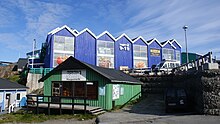
Services
KNI and its subsidiary Pilersuisoq, a state-owned chain of all-purpose general stores in Greenland, are based in Sisimiut.[23] The Pilersuisoq chain operates in all small settlements in the country, as well as smaller towns which are not covered by supermarket chains. A range of shops operate in Sisimiut, from chain supermarkets of Pisiffik and Brugsen to independent outlets, also serving supplies to the smaller settlements in the region.[24] Other facilities include two banks,[25] a library, a Post Greenland office[26] and a small hospital/health center with 19 beds.[27]
Industry

There are advanced plans for the Alcoa aluminium smelting plant. Maniitsoq, the second-largest town in the municipality, is another proposed location alongside Sisimiut. The plant would provide employment for 600–700 people,[28] or more than 10 percent of the population. As it is a vital decision for the town, wide public consultations were carried out in 2008–2010[29][30][31] by both the town authorities and the Government of Greenland in order to address potential environmental and social concerns.[32][33]
Energy
The Sisimiut Hydro Power Plant is under construction north of the town.[34] The plant will have two turbines providing 15 megawatts of power. The electricity available to the town is nearly half of that number (8.2 megawatts), produced by diesel generators.[35] The electricity from the new plant will be transferred to Sisimiut by a new 27.4 km (17.0 mi) long high voltage line.
Polaroil
Polaroil, a liquid fuel distribution company,[36] is headquartered in Sisimiut.[37] It employs 70 staff and operates 70 stations in Greenland.[36] The headquarters were moved from Maniitsoq to Sisimiut in late 2000s.[37] In 2010 KNI announced plans to also move the operational base of Polaroil from Maniitsoq to Sisimiut, causing protests in the former community[37] already experiencing depopulation.[38]
Housing
Most families in Sisimiut live in single-family houses, most often the traditional colorful wooden pre-fabricated buildings shipped from Denmark, and almost always raised or supported by a concrete foundation due to permafrost. In the 1960s, the then Danish authorities began construction of communal apartment blocks in most towns in Greenland, including Sisimiut.[14]
Unlike in Nuuk, the modern environmental-friendly construction technologies have not yet arrived to Sisimiut, and as of 2010 the existing communal-block district remains in a state of partial disrepair. The Qeqqata municipality however is planning the town expansion in the 2010s, with the area north of the Kangerluarsunnguaq Bay reserved for real estate.[39] The new neighborhood will bear the name Akia.[40]

Education
The Knud Rasmussen High School (Knud Rasmussenip Højskolia), founded in 1962,[12] is located on the eastern outskirts of the town, west of the old heliport site. Apart from the traditional curriculum, it provides specialized courses in Greenland history and culture. The school is also notable for its special unit, the Women's High School (Greenlandic: Arnat ilinniarfiat) added in 1977, and focusing on traditional arts.[41]
The other educational centers in Sisimiut are: Sanaartornermik Ilinniarfik, the construction engineering school with capacity for 200 students,[42] the Arctic Technology Centre; Piareersarfik, the vocational institution for the service industry professionals, and Oqaatsinik Pikkorissarfik, a foreign language school.[43][44]
Taseralik Culture Center

The modern Taseralik Culture Center (Greenlandic: Taseralik Kulturikkut) is located in the eastern part of Sisimiut, on the shore of the Nalunnguarfik lake. The center often hosts traveling theatre troupes,[45][46] as well as concerts, from classical[47] to folk music.[48] The Sisimiut Culture Day on 21 November is also celebrated at Taseralik.[49]
Tourism
Tourist facilities in Sisimiut include a youth hostel (Danish: vandrehjem), several hotels, and a conference centre.[50] The town has a heated open-air swimming pool, which is supported on stilts so that the heat does not melt the permafrost. Several camping sites are located in Sisimiut valley and near the Kangerluarsunnguaq bay. During winter, a ski lift operates at the foot of the Alanngorsuaq mountain, at the base of the northern slopes of Nasaasaaq.[15]
Tourism is becoming increasingly important, with several outfitter companies based in town. Year-round operations offered include dogsledding, heliskiing, guided hiking, mountaineering, kayaking, and boating.[51] The tough, 160 km (99 mi) long Arctic Circle Race takes place each winter, with the trail partially overlapping with the Polar Route from Sisimiut to Kangerlussuaq.[52] The race was inaugurated in 1998, since then becoming an international competition.[53]
Population
With 5,460 inhabitants as of 2010,[54] Sisimiut is one of the fastest-growing towns in Greenland,[55] with migrants from the smaller settlements reinforcing the trend. Apart from Kangerlussuaq, it is the only settlement in the Qeqqata municipality exhibiting stable growth patterns over the last two decades.
The gender imbalance is evident in Sisimiut, with men consistently outnumbering women during the last two decades, running from 20 percent in 1991, to 13 percent in 2000 and 2010. Nearly 10 percent of the town's inhabitants as of 2010 were born outside Greenland, a decline from 16.5 percent in 1990 and 11.8 percent in 2000.[55]
Transport

Air
The airport at Sisimiut is located 4.1 km (2.5 mi) to the northwest of the town, at the mouth of the Kangerluarsunnguaq Bay. It has a short, 799 m (2,621 ft) runway[19] suitable only for STOL airplanes. Travel outside of Greenland is routed with a change of planes at Kangerlussuaq Airport. Air Greenland operates scheduled services to Nuuk, Maniitsoq, and Ilulissat.[56] Taxis as well as an infrequent town bus service connect the airport with the center of Sisimiut.

Sea
For most of the year, Sisimiut is served twice-weekly by coastal ferries of Arctic Umiaq Line which link the communities of the western coast.[57] There is also a weekly Royal Arctic Line ferry to Itilleq and Sarfannguit.[58]
The port in Sisimiut is the northernmost year-round ice-free port in Greenland,[15] serving as the country's primary maritime base north of Nuuk. Supply ships from the port head north, serving the entire coast, from the Uummannaq Fjord region, through Upernavik Archipelago, to Qaanaaq in the far north.[59] M/S Akamalik, one of the largest ships in the fleet of Royal Greenland, is based in Sisimiut. The port also handles more than 50 cruise liners per year.[59] The port is also home to the first shipyard of Greenland, built in 1931.[12]

Ground
Roads in Sisimiut, including the road to the airport, are surfaced, but there is no road linking Sisimiut to any other settlement. In the 2000s construction of the 170 km (110 mi) road to Kangerlussuaq was discussed for several years without resolution.[60] The road would have been the first of its kind in Greenland, connecting two settlements, and reducing the need for passenger exchange at Kangerlussuaq Airport, the Air Greenland hub.
The town has its own bus network.[61] In winter dog sled routes are a key transport link to settlements further north.
Twin towns
Sisimiut is twinned with:
Sisimiut has friendship links with:
Notes
References
- ^ "Nye direktører i Qeqqata Kommunea". Sermitsiaq (in Danish). 3 January 2009. Retrieved 3 July 2010.
- ^ "Sisimiut" (in Danish). KANUKOKA, Official Website. Retrieved 12 July 2010.
- ^ a b Fog Jensen, Jens (2009). The Stone Age of Qeqertarsuup Tunua (Disko Bugt): A regional analysis of the Saqqaq and Dorset Cultures of Central West Greenland. Museum Tusculanum Press. pp. 26–31. ISBN 978-8763512725.
- ^ a b c d "Saqqaq culture chronology". Greenland Research Centre at the National Museum of Denmark. Retrieved 12 July 2010.
- ^ a b c d "About Sisimiut". Arctic Circle Race. Retrieved 12 July 2010.
- ^ "Cultural-historical hikes". Sisimiut Town, Official Website. Retrieved 12 July 2010.
- ^ "Analysis of hair DNA reveals ancient human's face". BBC. 10 February 2010. Retrieved 12 July 2010.
- ^ "Udstillinger på Sisimiut Museum" (in Danish). Kalaallit Nunaanni Katersugasiviit. Retrieved 12 July 2010.
- ^ a b "Early Dorset/Greenlandic Dorset". Greenland Research Centre at the National Museum of Denmark. Retrieved 12 July 2010.
- ^ "History". Sisimiut Town, Official Website. Retrieved 12 July 2010.
- ^ "Aasivissuit, Arnangarnup Qoorua (Greenlandic inland and coastal hunting area)". UNESCO. Retrieved 12 July 2010.
- ^ a b c d e "Sisimiut Tourist Information". Greenland Guide. Retrieved 12 July 2010.
- ^ "Celebrating the Self-Government Day". Government of Greenland. Retrieved 9 July 2010.
- ^ a b c d "Sisimiut". Sisimiut Town, Official Website. Retrieved 3 July 2010.
- ^ a b c d e f g h i O'Carroll, Etain (2005). Greenland and the Arctic. Lonely Planet. pp. 158–160. ISBN 1-74059-095-3.
- ^ "Celebrating the Self-Government Day". Government of Greenland. Retrieved 9 July 2010.
- ^ "Administrationen". Qeqqata Municipality, Official Website. Retrieved 12 July 2010.
- ^ a b c d e Vandrekort Vestgrønland: Sisimiut (Map) (1996 ed.). Cartography by Compukort, Denmark. Greenland Tourism a/s.
- ^ a b Greenland AIP for 864 – {{{3}}} from Naviair
- ^ a b O'Carroll, Etain (2005). Greenland and the Arctic. Lonely Planet. p. 163. ISBN 1-74059-095-3.
- ^ "Water supply". Sisimiut Town, Official Website. Retrieved 5 July 2010.
- ^ a b "Klimanormaler for Grønland" (in Danish). Danish Meteorological Institute. Retrieved 11 July 2010.
{{cite web}}: Cite has empty unknown parameter:|1=(help) - ^ "KNI a/s". Pilersuisoq, Official Website. Retrieved 27 August 2010.
- ^ "Retailers". Sisimiut Town, Official Website. Retrieved 12 July 2010.
- ^ "Banks". Sisimiut Town, Official Website. Retrieved 5 July 2010.
- ^ "Post offices". Sisimiut Town, Official Website. Retrieved 5 July 2010.
- ^ "Sisimiut Sundhedscenter" (in Danish). Qeqqata Municipality. Retrieved 5 July 2010.
- ^ "Aluminium smelting plant". Sisimiut Town, Official Website. Retrieved 5 July 2010.
- ^ "Alcoa holds town hall meeting in Sisimiut". Sermitsiaq. 15 January 2008. Retrieved 5 July 2010.
- ^ "Where should Alcoa plant be located?". Sermitsiaq. 21 February 2008. Retrieved 5 July 2010.
- ^ "Alcoa in Greenland". Alcoa. Retrieved 5 July 2010.
- ^ "Alcoa project can paralyse building sector". Sermitsiaq. 13 April 2008. Retrieved 5 July 2010.
- ^ "Alcoa eller ej". Sermitsiaq (in Danish). 25 March 2010. Retrieved 5 July 2010.
- ^ "Power supply in Sisimiut Municipality". Sisimiut Town, Official Website. Retrieved 5 July 2010.
- ^ "Electricity supply". Sisimiut Town, Official Website. Retrieved 5 July 2010.
- ^ a b "Polaroil". KNI, Official Website. Retrieved 27 August 2010.
- ^ a b c "Ruth H. i oprør". Sermitsiaq. 12 January 2010. Retrieved 27 August 2010.
- ^ "Population in localities January 1.st by locality, age, gender and place of birth 1977-2010". Statistics Greenland. Retrieved 27 August 2010.
- ^ "Commercial and Industrial Development". Sisimiut Town, Official Website. Retrieved 3 July 2010.
- ^ "Akia - Pilersaarusiaq Lokalplan" (PDF) (in Danish). Sisimiut Town, Official Website. Retrieved 27 August 2010.
- ^ "Arnat Ilinniarfiat" (in Greenlandic). Knud Rasmussenip Højskolia. Retrieved 3 July 2010.
{{cite web}}: CS1 maint: unrecognized language (link) - ^ "Sanaartornermik Ilinniarfik". Sanaartornermik Ilinniarfik. Retrieved 5 July 2010.
- ^ "Training and education". Sisimiut Town, Official Website. Retrieved 12 July 2010.
- ^ "The aim of Oqaatsinik Pikkorissarfik". Oqaatsinik Pikkorissarfik. Retrieved 12 July 2010.
- ^ "Stor interesse for 'Illerngit' i Sisimiut". Sermitsiaq (in Danish). 22 November 2009. Retrieved 3 July 2010.
- ^ "Slædespor i Sisimiut". Sermitsiaq (in Danish). 17 November 2009. Retrieved 3 July 2010.
- ^ "Operasucces i Sisimiut". Sermitsiaq (in Danish). 22 May 2009. Retrieved 3 July 2010.
- ^ "Rasmus i Taseralik". Sermitsiaq (in Danish). 6 May 2008. Retrieved 3 July 2010.
- ^ "Kulturdag i Sisimiut" (in Danish). Taseralik Kulturikkut. Retrieved 3 July 2010.
- ^ "Accomodation". Sisimiut Town, Official Website. Retrieved 5 July 2010.
- ^ "Activities in Sisimiut". The Official Tourism and Business Site of Greenland. Retrieved 3 July 2010.
- ^ "Race setup". Arctic Circle Race. Retrieved 3 July 2010.
- ^ "Arctic Circle Race". The Official Tourism and Business Site of Greenland. Retrieved 3 July 2010.
- ^ "Greenland in Figures, 2010" (PDF). Statistics Greenland. Retrieved 12 July 2010.
- ^ a b c "Population in localities January 1.st by locality, age, gender and place of birth 1977-2010". Statistics Greenland. Retrieved 12 July 2010.
- ^ "Booking system". Air Greenland. Retrieved 2 July 2010.
- ^ "AUL, Timetable 2009" (PDF). Arctic Umiaq Line. Retrieved 12 July 2010.
- ^ "Ankomster / Afgange, Angaju Ittuk" (in Danish). Royal Arctic Line. Retrieved 12 July 2010.
- ^ a b "Sisimiut Harbour". Sisimiut Town, Official Website. Retrieved 5 July 2010.
- ^ "Arctic Roads". Sisimiut Town, Official Website. Retrieved 3 July 2010.
- ^ "Busser" (in Danish). Sisimiut Town, Official Website. Retrieved 5 July 2010.
- ^ "AVF - Albertslund Venskabsby Forening" (in Danish). Albertslund Kommune. Retrieved 2010-07-04.
- ^ "Twinning contacts". Canterbury City Council. Retrieved 2010-07-04.


